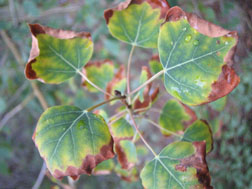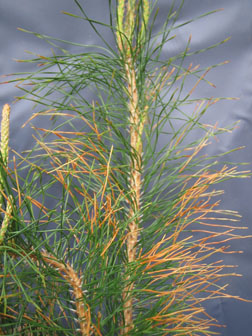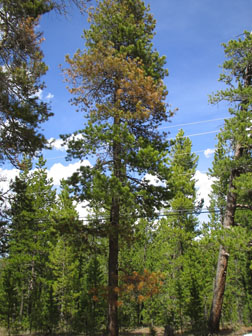Quick Facts…
- Magnesium chloride (MgCl2) is a salt compound composed of Mg+2 and Cl– ions.
- Magnesium chloride (MgCl2) is used as a dust suppressant and road stabilizer on nonpaved roads and as a deicing product on paved roads and sidewalks.
- MgCl2 based products can move from treated roads into adjacent soils through precipitation.
- Trees take up soil magnesium and chloride through roots and accumulate them in leaves.
- To avoid chloride toxicity in roadside trees, use non-chloride based products to treat for dust suppression and deicing purposes.
MgCl2 Uses for Road Treatments
Along highways and city streets, liquid magnesium chloride (MgCl2) deicing solutions are applied during snow events, as preventative deicers, and as anti-icing treatments. Granulated MgCl2 is also commonly applied to sidewalks, driveways, and walkways in smaller quantities. Liquid MgCl2 solutions are applied to non-paved roads during spring and summer months for dust suppression and road stabilization, especially in arid regions.
MgCl2 Toxicity: Biology
Chloride (Cl–) and magnesium (Mg+2) are both essential nutrients important for normal plant growth. Too much of either nutrient may harm a plant, although foliar chloride concentrations are more strongly related with foliar damage than magnesium. High concentrations of MgCl2 ions in the soil may be toxic or change water relationships such that the plant cannot easily accumulate water and nutrients. Once inside the plant, chloride moves through the water-conducting system and accumulates at the margins of leaves or needles, where dieback occurs first. Leaves are weakened or killed, which can lead to the death of the tree.
Symptoms of Chloride Toxicity
 |
Chloride toxicity in woody plants initially develops as a marginal necrosis on deciduous leaves (Figure 1) or a tip burn or necrosis on conifer needles (Figure 2). Generally, the higher the foliar chloride concentrations, the more extensive the necrosis becomes. In prolonged exposures, necrosis moves toward the middle of the leaf in deciduous species and towards the base of the needle in conifers. Early leaf loss can also occur.
Necrosis is usually more severe on older conifer needles (i.e., those nearest the trunk). Sometimes newly flushed, or current season, needles are unaffected and remain green throughout the summer and fall. Deciduous species may not exhibit symptoms for several months after flushing new leaves. In some cases, foliar damage may appear on branches in a spiral pattern in the tree crown (Figure 3).
Some symptoms associated with exposure to deicing salt spray, aerosols, or road dust differ from root absorption. The side of the tree facing the road may exhibit more damage and needles may have surface deposits of salt crystals or dust. Trees exposed to MgCl2 aerosols are often, but not always, in soils with high MgCl2 concentrations and thus may show a range of symptoms.
 |  | |
Abiotic Disorders Similar to Chloride Toxicity
Drought effects, dehydration, winter burn, and some herbicide damage also appear as tip or marginal burning on trees. Water stress and dehydration may exacerbate chloride toxicity and cause even more extensive damage. There is no known method to fully separate the symptoms of chloride toxicity from water stress.
Diagnosis
 |
Eliminating other major biotic (insects, diseases) or abiotic (herbicide) damages to trees is the first diagnostic step, although these issues may also occur on trees already stressed by chloride toxicity. The next major factors useful in determining whether a tree is exposed to chloride are position and distance from the road, position in drainage or culvert areas, and eventually measuring chloride concentration in foliage.
Source: CSU Extension

